Back to: legs
Forward to: ozopores
Sternites
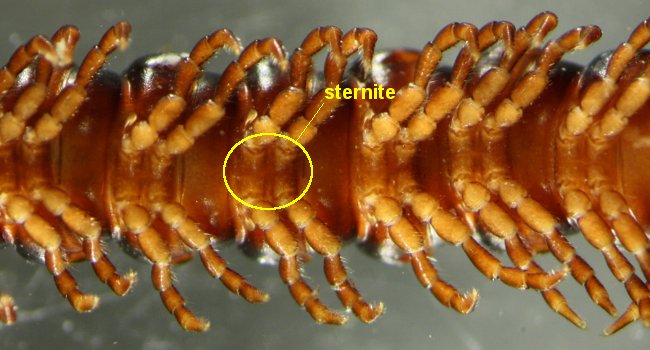
Above and next below: Somethus tasmani (Paradoxosomatidae), Tasmania
The word sternite when applied to millipedes means two different things. It may refer to the sternite plate which makes up the ventral part of a body ring (see the haplosegments page). More usually, millipede specialists use the word 'sternite' to mean the structure to which the legs attach (images above and below). This structure sits outside the bounding line of the body ring (below, right) but is an integral part of that ring.
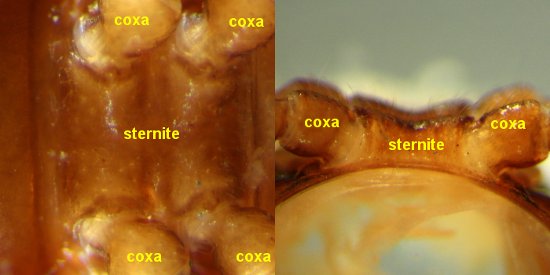
Ventral (left) and posterior (right) views of midbody sternite.
At first glance, sternites look simple. The sternites on the diplosegments (above), which are sometimes called diplosternites, have four holes, one for each of the legs attaching to that ring. The sternites on the haplosegments (and on ring 7 of males older than stadium 3) support the coxae of two legs.
However, sternites in Polydesmida vary in interesting ways, even on the same animal, and it is worth examining all the sternites on a specimen to look for features useful in identifying or classifying.
Look first at the relative width and length of the diplosternites. In many species the diplosternite is about as wide as long (images above). In species with short legs which are closely protected by low-set paranota, the distance between the two coxae of a leg pair is usually small, which makes the sternite longer than wide (below, left). Diplosternites may also be wider than long, and the length/width ratio can vary between sexes in the same species.
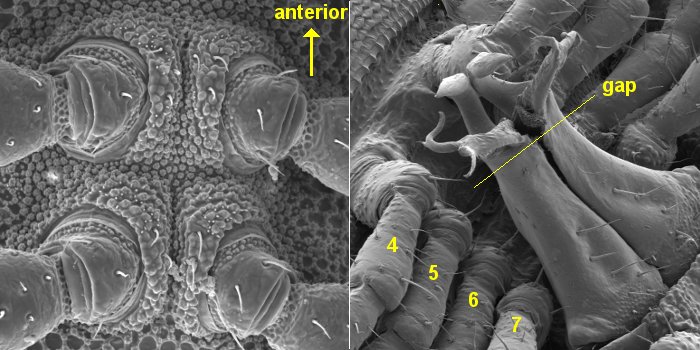
Left: Agathodesmus steeli (Haplodesmidae), New South Wales, Australia
Right: Asphalidesmus magnus (suborder Dalodesmidea), Queensland, Australia
Diplosternites are sometimes flat, but more usually they have 'cross impressions': shallow grooves in the form of a cross. Sometimes the transverse impression is obviously deeper than the longitudinal impression, as in Somethus tasmani (top of page), but in other species the opposite is true.
Important variations appear on the anterior rings in adult males. The sternites are usually widened and 'excavated' in the middle, creating a wide gap in which the gonopods can lie when retracted; see the image above, right, which shows the gonopods of Asphalidesmus magnus. The sternites modified this way in male Polydesmida are usually just those along the length of the retracted gonopod. In A. magnus, the excavated sternites are on rings 5 (legpairs 4 and 5) and 6 (legpairs 6 and 7).
Excavated sternites often have tufts of setae or other structures which support the retracted gonopods. In the image at left, below, the anterior part of the diplosternite on ring 5 has short, setae-topped 'bumps' close to the leg 4 coxae. Note that the spacing between legs 5 is wider than the spacing between legs 4 in this species. In the species at right, below, the leg spacing is very wide on ring 6, and there are four tufts of setae supporting the gonopods: two at the anterior edge of the 'excavation', and two close to the leg 7 insertion points. Across the Polydesmida there are hundreds of variations on details like these, many of them peculiar to just one species.
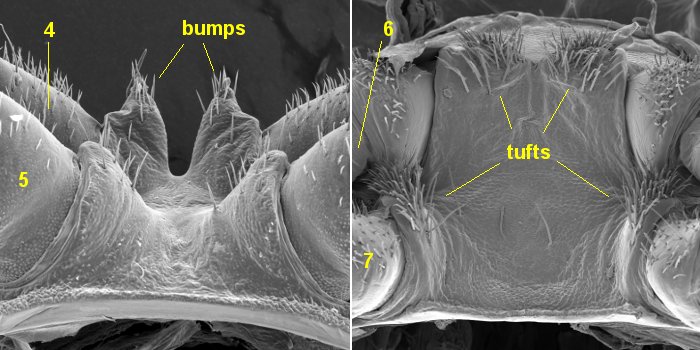
Left: Noteremus summus (suborder Dalodesmidea), Tasmania; posterior view of ring 5 sternite
Right: Tasmaniosoma warra (Dalodesmidae), Tasmania; ventral view of ring 6 sternite
Tufts of setae are found on other sternites as well as those supporting the gonopods, so that some sternites may look 'hairier' than others. The most striking variations in sternites, however, are in the big range of 'growths' from their surfaces, almost always in adult males. One sort of growth, the sternal lamella, is common in Paradoxosomatidae and is shown on the sex differences page. There are many others — see below for just two examples: paired 'finger' processes at different positions on different rings.
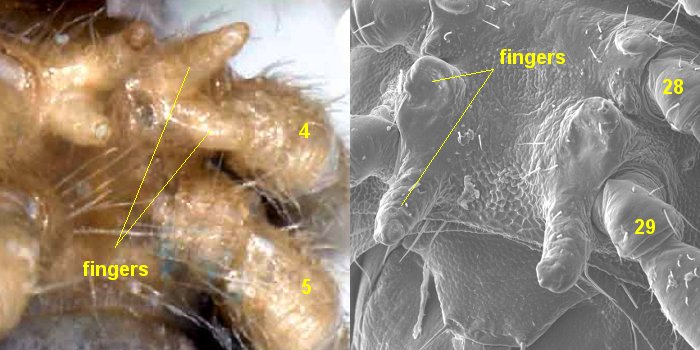
Left: Orthomorpha enghoffi (Paradoxosomatidae), Thailand
Right ventrolateral view of ring 5
Processes on anterior part of sternite
(Image courtesy N. Likhitrakarn)
Right: Atrophotergum pastorale (Dalodesmidae), Tasmania
Ventral view of ring 17 sternite
Processes on posterior part of sternites on last few rings
Back to: legs
Forward to: ozopores
